12 Types of Computer Networks: LAN, MAN, WAN Explained
As the number of connected personal and IoT devices grows around the world, so does the demand for high-speed, high-performance networks, which are transforming how people and businesses connect.
This technological advancement has prompted the development of various types of networks to meet shifting demands over the years, and it is likely that more network topologies will emerge in the future as technology advances. It has never been more important to reduce network blind spots and implement network monitoring tools.
We’ve compiled a list of common network types and provided some advice on how to choose one. After reading this article, you will be able to:
- Discover the most commonly used network topologies and terminologies.
- Learn how to choose between various types of network connections.
So, whether you’re a network veteran or a new network manager, you’ll learn something from this article. Let’s get started!
What are the various types of networks?
1. Local Area Network (LAN)
When you connect your laptop or mobile phone to your home or office network, you are using a local area network (LAN).
This type of network (LAN) is a proprietary computer network that allows designated users to have exclusive access to the same system connection at a common location, always within a mile and most often within the same building. As a result, they can share devices, resources such as printers, and information as if they were all working from the same system. A network-aware operating system allows for resource sharing.
LANs, which were originally used in universities and research labs, are now used everywhere, including in homes and businesses. Different types of network topologies, such as bus, star, and branching tree, are used to achieve specific goals using coaxial cables, optical fiber cables, or twisted wire pair. Wi-Fi and TCP/IP Ethernet allow for information sharing and communication between devices across different topologies.
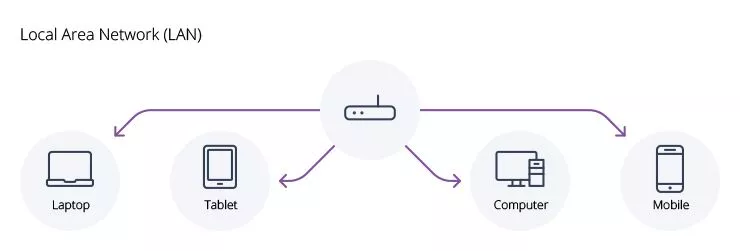
When to Use a Local Area Network:
- If you have a large number of users who need to connect in a single location.
- When devices and resources within a small geographic area must communicate directly with one another.
When not to use a LAN:
- Connecting users separated by large distances, such as cities.
- If you don’t have control over the assets that connect to your network, you should be cautious about configuring a LAN for them to communicate.
2. Personal Area Network (PAN)
A personal area network (PAN) is a short-range network type designed for peripheral devices used by an individual (typically 30ft). The goal of these networks is to transfer data between devices that are not necessarily connected to the internet.
PANs can also be linked to LANs and higher level networks, with one device serving as a gateway. A common example of PAN is a Bluetooth keyboard connected to a smart TV, with an interface that allows you to surf the internet, watch recorded programmes, and configure personal preferences.
Personal area networks can be wired or wireless. For data-centric applications, wireless PANs (WPANs) use close-range connectivity protocols such as Wi-Fi, ZigBee, infrared, and Bluetooth. Bluetooth network configurations can be piconets (a master and one or more slaves) or scatternets (interconnected piconets).
Wired PANs, on the other hand, make use of USB and Thunderbolt. Each connectivity protocol within a PAN, like other network types, is not always directly compatible with other protocols.

When to use a PAN:
- You want to connect accessories or peripherals to laptops, cell phones, and so on.
- In most cases, the devices do not require direct internet access.
When not to use a PAN:
- You want to share resources among different users.
- The distance between the devices is several feet.
3. Wireless Local Area Network (WLAN)
Wireless technologies have made significant advances in commercial and personal connectivity, opening up a wide range of possibilities such as mobile wireless, fixed wireless, portable wireless, and infrared wireless. Devices connected in these configurations communicate via a wireless local area network (WLAN).
WLANs use high-frequency signals, lasers, and infrared beams to allow devices (also known as clients) to communicate with one another without the use of electrical conductors (wires). This type of flexible data communication allows users to move around a coverage area while maintaining network connectivity without the use of cables.
WLAN has a high data transfer rate and typically operates in the 2.4 GHz or 5 GHz bands. Bluetooth devices, cordless telephones, Wi-Fi radios, and garage door openers are some examples of devices that operate in the 2.4 GHz band over a WLAN. Laptops can be connected to the 5 GHz band if you want to sacrifice some signal strength for faster WLAN speeds.
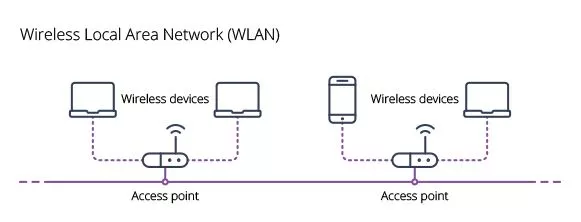
When to use a WLAN:
- Device mobility is critical while connected to a network.
- Your devices do not support wired network connections.
- You must connect devices that are not physically close to the existing network infrastructure.
- You need to connect more devices than the number of ports on your router or switch, and you can’t add another switch or router.
When not to use a WLAN:
- It is critical to deliver consistent, unwavering performance.
- The only priority is security.
- Data transfer rates are higher than those offered by wireless technologies.
4. Wide Area Network (WAN)
Private lines, virtual private networks (VPNs), multiprotocol label switching (MPLS), wireless networks, cellular networks, and the internet enable LANs and other types of networks to communicate and transmit data across geographical boundaries. This type of computer networking is known as a wide area network (WAN), which is a non-geographic telecommunication network that provides access to various forms of media via a designated provider.
WANs can be simple or complex, with point-to-point or packet-switched networks on shared circuits. Different connection types, such as virtual private networks (VPNs) and multiprotocol label switching, are used in hybrid WAN and SD-WAN (MPLS). Communication channels within a WAN frequently use a variety of technologies, including routers, FSO links, and I/O interfaces, as well as fibre optics.
While they go unnoticed most of the time, WANs are ubiquitous in modern life, connecting cities, countries, and even space. From providing remote access to a corporation’s headquarters to allowing students to communicate with other students on different continents to real-time teleconferencing, these and many other examples demonstrate how far-reaching WANs have become.

When to use a WAN:
- You have devices spread across a large geographic area that must communicate directly with one another.
When not to use a WAN:
- The only consideration is cost, as some WAN technologies, such as leased lines, can become prohibitively expensive.
- Because the performance of some WAN technologies varies, consistency is essential.
5. Metropolitan Area Network (MAN)
Efficiency and speed are top priorities in today’s computer networking world. Some technologies provide both, while others provide only one or none at all. By utilizing technologies such as fiber optics, dense wavelength division multiplexing, and optical packet switching, a metropolitan area network (MAN) checks both boxes.
A typical metropolitan area network layout (MAN) Science Direct is the source.
MANs, also known as medium-sized networks, cover an area larger than a LAN but smaller than a WAN. They are made up of various LANs that are linked together using point-to-point high-capacity backbone technology and can span several buildings or a city.
MANs can take the form of a cable TV network or even telephone networks that provide high-speed DSL lines thanks to shared regional resources.

When to use a MAN:
- You have devices spread over a regional geography that need to communicate directly with each other.
- You have the ability to provide connectivity, wired or wireless, between each location.
When not to use a MAN:
- Cost is a primary requirement, as less expensive methods of connecting sites may exist.
- The devices to be connected are dispersed across a larger geographical area.
6. Campus Area Network (CAN)
A campus area network (CAN) connects different LANs from various departments sharing a common area at universities, colleges, and corporate campuses. This combines previously disparate networks into a unified network that provides access to information at breakneck speeds while ensuring the necessary authentication to prevent privacy breaches.
The operational approach of CANs is similar to that of LANs, but the size of these networks differs. Users who connect to a CAN with multiple devices frequently use Wi-Fi, hotspots, and Ethernet technology.
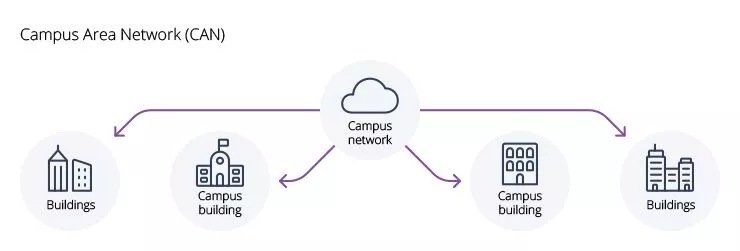
When to use a CAN:
- You have devices all over campus that need to communicate with one another.
- You have the ability to provide wired or wireless connectivity between each building.
When not to use a CAN:
- Cost is a primary requirement, as less expensive methods of connecting sites may exist.
- Devices to be connected are dispersed across a larger geographic area, rather than being restricted to the campus.
7. Virtual Private Network (VPN)
With cyberattacks lurking around every corner and the risk of sensitive information being mined, intercepted, or even stolen, a virtual private network (VPN) provides users with an encrypted connection that effectively conceals data packets while using the internet.
This is accomplished by establishing a VPN tunnel between two communicating devices, encapsulating and encrypting the data transferred between the two devices. When two devices are connected via a public network, such as the internet, a VPN is typically used. The VPN tunnel’s additional security prevents sensitive information such as IP addresses, browsing history, communication with a corporate office, or even travel plans from being exposed online.
The level of security surrounding a data packet is determined by the VPN tunnel used. Point-to-point tunnelling protocol (PPTP), Secure Socket Tunneling Protocol (SSTP), L2TP/IPsec, and OpenVPN are examples of common VPN tunnels.
Layer 2 Tunneling Protocol (L2TP) that uses Internet Protocol Security (IPsec) protection typically uses AES-256 bit encryption, which is considered the strongest available for all types of network connections.
VPNs are classified as either remote access VPN or site-to-site VPN. Users securely connect their devices to the corporate office using remote access VPNs. The connection is made from a corporate office to a branch using site-to-site VPN.
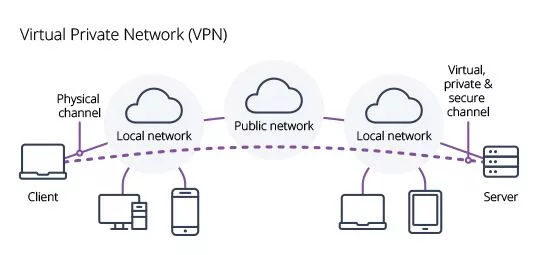
When to use a VPN:
- You need to facilitate secure communications between two locations but lack direct connectivity between them.
- Remote users must have remote access to resources stored in a central location.
When not to use a VPN:
- Your only concern is for speed. The encryption process adds a small amount of overhead to communication.
8. Enterprise Private Network (EPN)
Bandwidth-intensive applications consume a significant portion of a company’s network resources, slowing data transfer and causing bottlenecks in business operations. An enterprise private network (EPN) is a network that a company builds and operates to share company resources. It connects a company’s offices in different geographical regions and is optimized to ensure that bandwidth-intensive applications run smoothly without clogging the network.
Companies using an EPN can opt for a fully private, purpose-built network or a hybrid integrated with a network Communications Service Provider (CSP). To ensure privacy across all network operations, EPNs are optimized with tunneling protocols such as Layer 2 Tunneling Protocol (L2TP) and Internet Protocol Security (IPsec). MPLS technology is used to connect branches.
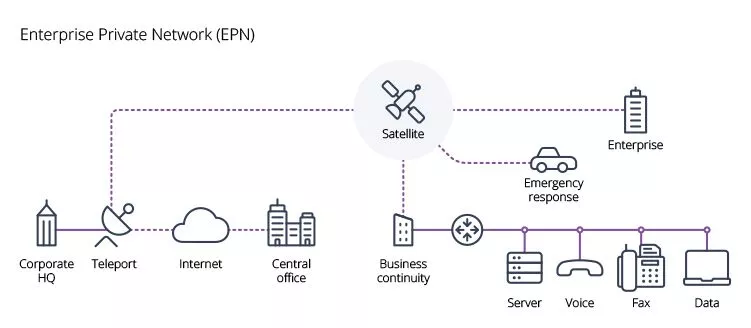
When to use an EPN:
- You need to facilitate secure communications between two locations but lack direct connectivity between them.
- You must provide users in various locations with consistent access to resources in various locations.
- There are requirements for the network to scale and grow over time.
When not to use an EPN:
- Your network team is limited in resources. EPNs take more time to set up, update, and maintain.
- Redundant links between locations are not possible because they introduce more failure points into the network.
9. Storage Area Network (SAN)
In an increasingly competitive world, network storage is synonymous with business continuity. Businesses that want to stay competitive must find ways to optimize data access and storage, as well as ensure that critical backups are performed on a regular basis. Using a storage area network is one way to achieve these and other goals (SAN).
A storage area network (SAN), also known as a network behind the servers, is a high-speed computer network that provides any-to-any storage access. The primary function of a SAN is to transfer data between storage devices as well as between the computer network and storage devices.
The majority of SANs provide block-level I/O services. Fiber channel technologies such as fiber channel host bus adapter (HBA) cards and fiber channel switches, as well as other technologies such as hosts, switches, and disc arrays, may be used in a SAN.

When to use a SAN:
- Multiple devices must share the resources available on one or more storage devices.
- Data storage must be centralized across all resources.
When not to use a SAN:
- You have a limited budget. A significant upfront investment may be required to establish a SAN.
- You have limited resources. SANs may necessitate more maintenance and upkeep than local storage.
10. System Area Network (also referred to as SAN)
A system area network (SAN) is a network configuration that allows nodes in a cluster to communicate with one another. It is intended to provide high bandwidth and low latency in a high performance computing environment by avoiding multiple copies of data and providing direct network access to users.
As a result, SANs provide high-speed switched environments that enable device-to-device network communication. A SAN can also connect to multiprocessing systems (processor-to-processor) and storage area networks (SANs).
Because SANs are intended for use in parallel computing environments, common applications include scientific applications, database server clusters, and file server clusters.
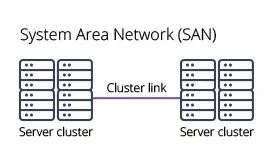
When to use a system area network:
- You require low error rates, high bandwidth, and low latency when transferring data.
- You are not cost-conscious.
When not to use a system area network:
- The network requirements do not include the significant investment that may be required to set up a system area network.
11. Passive Optical Local Area Network (POLAN)
Once upon a time, copper-based connectivity was widely used in local area network (LAN) installations. This scenario is changing today as passive optical local area networks (POLAN) supplant older installations.
POLAN is a significant advancement over copper cables, replacing them with fiber-optic telecommunications technology that uses optical splitters to split and combine upstream and downstream signals before sending them on a strand of single-mode fiber.
The bandwidth of the fiber is divided among different access points, and the use of wavelength division multiplexing (WDM) enables bidirectional communication, reducing the number of copper cables.
POLAN is used in campus buildings where departments share a common network, hospitals with a shared network that includes on-site pharmacy and patient needs, and any other LAN network type.
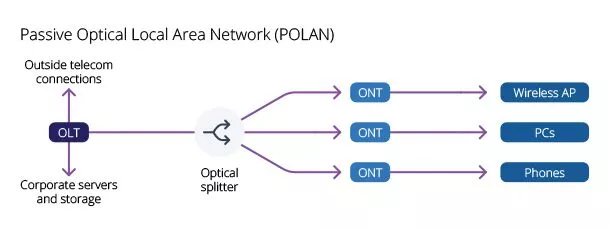
When to use a POLAN:
- You require a low-cost solution for connecting remote locations, as well as the ability to install optical fiber between them.
When not to use a POLAN:
- Your network requires a well-defined standard. There are currently no globally accepted standards that define POLAN installations, which could lead to future compatibility issues.
- You have a limited budget.
12. Home Area Network (HAN)
It’s possible that many of the homes have more than one computer. A network that is analogous to the local area network (LAN) should be constructed inside of that home so that those computers, along with other peripheral devices, can communicate with one another. Home Area Network is the name given to the sort of network that gives users the ability to link several computers and other digital devices to one another within the confines of their homes (HAN). Within the network, HAN promotes users to share resources, files, and programs with one another. It is compatible with both wireless and wired forms of communication.
How to Select the Best Network for Your Company/Home?
The range and applicability of network types clearly differ, so choosing a network for your business means aligning with your business goals, the long-term outlook, and the physical realities of the devices that you want to connect.
When examining various types of networks, four important factors must be considered.
Purpose:
Networks are built and designed to achieve specific performance objectives. A system area network (SAN), for example, is better suited for high-performance computing environments. Combining a SAN with, say, a CAN on a corporate campus necessitates a thorough investigation into how these various types of networking topologies can complement each other in order to avoid high capital costs and idle resources.
Cost:
Both the short-term and long-term costs should be weighed against the performance metrics. Is it better to spend money on a WAN or an EPN? Maintenance costs are frequently overlooked during the investment stages, resulting in major surprises later on. Knowing how costs will evolve aids in developing the business case for selecting one network over another.
Availability :
Network entails more than simply being connected. Spare parts, upgrades, and software updates are all part of the availability process. Is a new technology employed? What will happen with spare parts and updates?
Scalability:
As more devices connect to a network, changes will be required to strengthen security, provide more bandwidth, ensure faster speeds, and plan for future growth. Scalability means thinking about the future.
ad


Comments are closed.